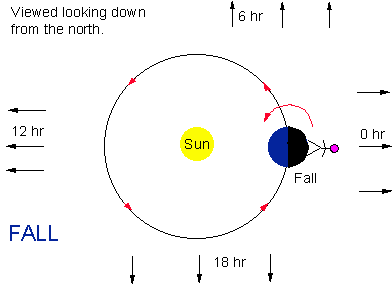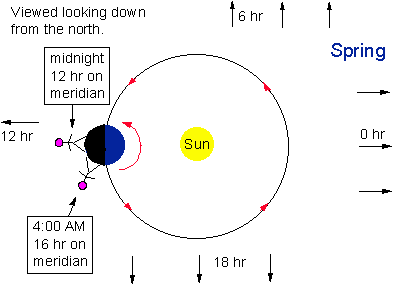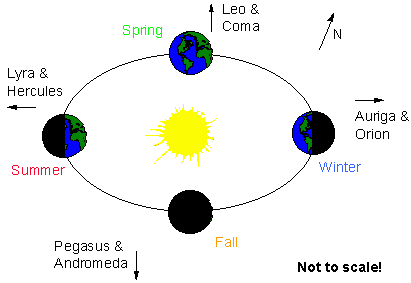Lecture
3: The
Night Sky - II
|
|

Lecture
Topics |
- The changing
sky (continued)
- Using RA and
Dec to find objects
- In-class
planetarium demonstration
- Magnitudes
- Fluxes and
magnitudes
|
|

Equatorial
Coords |
|
Astronomers use equatorial coordinates to locate objects on
the celestial sphere.
Right Ascension (RA or a)
- Equivalent to
longitude
- RA is measured
in hours
- The range is
from 0 to 24 hours increasing on sky towards the east.
- The "zero
point" is towards the constellation Pices.
Declination (Dec or d)
- Equivalent to
latitude
- Dec is measured
in degrees.
- The zero is on
the equator
- North Pole = 90
deg. , South Pole = -90 deg.
Notes:
- The equatorial
(celestial) coordinate system is fixed on the sky.
- The coordinates
of the stars and constellations do not change (ignoring precession).
- Since it is an
"earth-centered" system the coordinates of the sun do change.
The diagram below illustrates the definition of RA along the
equatorial plane and show the ecliptic plane and north celestial pole.
|
|

Equatorial
and
Ecliptic
Planes |
|
The diagram below illustrates the definition of RA along the
equatorial plane and show the ecliptic plane and north celestial pole.

|
|
|

Equinoxes
and the
Seasons
|
|
Definitions and the Seasons
The ecliptic intersects the equatorial plane at two
locations, the vernal equinox (0 hr RA) and autumnal equinox
(12 hr RA).
As the earth moves around the sun, the sun changes position
in the sky relative to the background stars. Thus the RA of the sun
changes every day.
For instance, on the first day of spring the sun is at the
location of the vernal equinox, RA = 0 hr. On the first day of fall the
sun appears in the direction of the autumnal equinox, RA = 12 hr.
The table below summarizes the location of the sun at the
beginning of each season.
|
Event
|
Sun's RA
|
Comment
|
|
first day of
spring
|
0 hr
|
Vernal Equinox
|
|
summer solstice
|
6 hr
|
|
|
first day of
fall
|
12 hr
|
Autumnal equinox
|
|
winter solstice
|
18 hr
|
|
|
|
|

The
Fall
Sky
|
The figure
below shows the location of the earth relative to the sun on the first
day of fall. At local midnight an observer (for instance, you!) is
standing on the opposite side of the earth from the sun and RA = 0 hr
is crossing the meridian. Looking to the eastern horizon you see RA = 6
hr while looking to the western horizon you see RA = 18 hr.
RA = 0 hr on
the meridian at midnight on Sep. 21.

The arrows
indicate the direction of the celestial sphere of RA = 0, 6, 12, and 18
hr. Note that the earth is not located at RA = 0 hr in this
diagram. The equatorial coordinate system is centered on the earth, so
the RA and Dec of the earth have no meaning.
|
|

The
Revolving
Earth |
| The Revolving Earth and the Changing Sky
Since the earth revolves around the sun, at the same
time each night, a different RA will be on the meridian at different
times of the year.
For instance at midnight for the following dates, the RA's
on the meridian are:
- Sep. 21 ===>
0 hr
- Dec. 21 ===>
6 hr
- Mar. 21 ===>
12 hr
- June 21 ===>
18 hr
The two figures below show "snapshots" of the sun-earth
system on the first day of winter and spring.
RA = 6 hr on
the meridian at midnight on Dec. 21.

RA = 12 hr
on the meridian at midnight on Mar. 21.

|
|

The
Rotating
Earth |
|
The Rotating Earth and the Changing Sky
As the earth rotates on its axis, the stars move
through the sky over the course of a night. Like the sun, planets, and
the moon, the stars rise in the east and set in the west due to the
earth's rotation.
Consider the case illustrated below. At midnight, RA = 0 hr
is on the meridian. As the earth turns, the observer moves. The graphic
illustrates the location of the observer at 4:00 AM. Now RA = 4 hr is
on the meridian and RA = 0 hr will appear west of the meridian to the
observer.
On the first day of fall (Sep. 21), RA = 0 hr on the
meridian at midnight. At 4:00 AM, RA = 4 hr will been on the meridian.

Six months later on the first day of sping (Mar. 21), RA =
12 hr is on the meridian at midnight. At 4:00 AM, RA = 16 hr will been
on the meridian.

|
|

Summary
of the
Changing
Sky |
|
The figure below gives an overview of the different parts of
the sky you can view different times of the year.

All observers (people) are shown at local midnight, except
for the fall where observers are shown at midnight, 4:00 AM, and noon.
|
|

Movement
of the
Sky |
|
Your general knowledge tells you that objects (sun, moon,
stars, etc.) rise in the east, cross the meriadian overhead, and set in
the west.
Due to the revolution of the earth about the sun, these
events happen earlier each successive night. Thus
- Each night a
given object will pass over the meridian 4 minutes earlier.
- This
corresponds to 2 hours earlier each month, or 24 hours in one year.
- Objects rise
and set earlier each day.
At a given
time, the RA crossing the meridian increases by 4 min. per day.
|
Example 1:
motion over the night
|
|
Suppose you see
a star on the meridian at midnight. As you watch it, it moves to the
west. So if you went out at 3:00 AM you would find the star west of the
meridian. Likewise, if you had gone out earlier you would find the star
east of the meridian.
|
|
Example 2:
motion over several months
|
|
Suppose you
observe a star on the meridian tonight at midnight. One month from now
you go out to look at the sky at the same time. The star would now
appear in the west. In fact, it would be "2 hours over" to the west.
(Note that the sky at 2:00 AM tonight will be the same as the sky at
midnight one month from now!)
|
|
|
|

Rotation
of the
Earth |
|
RA = 0 hr on the meridian at midnight on Sep. 21. At 4:00
AM, RA = 4 hr will be on the meridian. As illustrated in the figure
below this change is produced by the rotation of the earth.

|
|

Revolution
of the
Earth |
|
As illustrated below, when the earth has revolve around the
sun by 180 degrees (6 months). There is a new view of the sky. RA =
12hr on the meridian at midnight on Sep. 21. At 4:00 AM, RA = 16 hr
will be on the meridian.

|
|

Finding
an
Object |
|
You can either know when the constellation an object is in
is up or you can use the RA of the object to figure out when it is up.
The first figure below illustrates the constellation approach while the
second figure illustrates the RA approach.
Memorizing constellations and their availability is one way
to tell when an object is visible.

Learning how to
use an objects RA to determine visibility makes things much easier.
(Although maybe not as much fun.)

|
|

Finding
Orion |
| On what date is Orion on the meridian at midnight? At
3:00 AM? At 9:00 PM?
For the Orion Nebula (M42), RA = 5.5 hr, Dec = -5.5 degrees
RA =6 hr transits at midnight on Dec 21.
- => Orion
transits at midnight on Dec 14.
Also
- Orion transits
at 3:00 a.m. on Oct. 31.
- Orion transits
at 9:00 p.m. on Jan 28.
|
|

Example 1 |
|
What RA is on the meridian at a given date and time?
What RA is on the meridian at 3:00 am on Feb. 21?
- Dec. 21 -- 6 hr
on meridian at midnight
- Feb 21 -- 2
months later
=> add 4 hr
=> 10 hr overhead at midnight
- At 3:00 AM
=> 3 hr later, 13 hr on the meridian
|
|

Example 2 |
| On what day does a given RA cross meridian at a specific
time?
A constellation is at RA = 14 hr. On what day will it cross
the meridian at 9:00 PM?
- When 14 hr
crosses the meridian at 9:00 PM, 17 hr crosses the meridian at
midnight.
- On Mar 21: 12
hr crosses the meridian at midnight.
- 17 - 12 = 5
hours
=> 2.5
months (10 weeks)
=> June 7
|
|

More on
Finding
Objects |
- Circumpolar objects can be
visible any time of the year
- Example:
Polaris, the pole star.
- Southerly
objects are best observed during transit,
that is, when they cross the meridian.
|
|

What's
up
Tonight? |
What's "up" tonight?
- Go to the
A101/103 "Interesting
Astronomy Sites" list for links to what's happening in the sky.
- Observing
suggestions
- Best nights are
when the Moon is absent.
- Get away from
city glare.
- Get dark
adapted (about > 20 minutes)
- Use a "red
light" to look at star charts/maps so you keep your night vision
- Observing
suggestions
- Try to pick out
some "easy" constellations such as the Big Dipper, the Little Dipper,
Cygnus, and Cassiopea.
- Planets follow
close to the ecliptic (the path of the sun through the sky)
- Remember,
planets don't twinkle
- We will discuss
specific object to observe in class.
|
|

Magnitudes |
- We would like a
way of specifying the relative brightness of stars.
- Hipparchus
devised a the magnitude system 2100 years ago to classify stars
according to their apparent brightness.
- He labeled 1080
stars as class 0, 1,.. 6.
- 0 was the
brightest, 1 the next brightest, etc.
|
|

Magnitude
Scale |
- The magnitude
scale is logarithmic.
- An increase in
magnitude by 2.5 means an object is a factor of 10 dimmer, e.g.
- A zero mag star
is 10 times brighter than a 2.5 mag star.
- A zero mag star
is 100 times brighter than a 5 mag star.
|
|
|

Logarithms
|
|
Reminders about Logarithms
The table below list some sample base 10 logarithms.
|
Logarithm
function
|
Power
of 10
|
|
log
(10) = 1
|
101 = 10
|
|
log
(1) = 0
|
100 = 1
|
|
log
(0.1) = -1
|
10-1 = 0.1
|
|
log
(2) = 0.3
|
100.3 = 2
|
|
log
(3) ~ 0.5
|
100.5 ~ 3
|
|
log
(5) = 0.7
|
100.7 = 5
|
|
Note: If
we have z = 10x, then x is the
logarithm (base 10) of z. If z = ey then y is the
natural logarithm (base e, e = 2.71828) of z. Base 10 logarithms are
usually written as log10 or log, while nature logarithms are designated
with ln.
Reminder: We have 10x
* 10y = 10x+y.
To multiply (divide) two numbers, add (subtract) their logarithms and
take the anti-logarithm. In numerical terms, if x = log(A) and y =
log(B) then C = A*B can be determined from C = 10x+y.
|
|

Sample
Magnitudes |
|
The apparent visual magnitude of some of the brightest
objects in the sky are given below.
|
Object
|
Apparent
Magnitude
|
|
Sun
|
-26.8
|
|
Full
Moon
|
-12.6
|
|
Sirius
|
-1.47
|
|
Canopus
|
-0.72
|
|
Arcturus
|
-0.06
|
|
Betelgeuse
|
0.41
|
|
|
|

Magnitude
Limits |
| A dark adapted person with good eyesight can see to ~6th
magnitude.
Hubble Space Telescope can observe objects at ~30 mag.
4x109
times fainter than the eye!
|
|

Observing
at
Night |
Further suggestions on sky gazing
- Go to a dark
spot, away from city lights
- Large city has
3.5 mag limit.
- Country has 5.5
mag limit.
- Mountains have
6.5 mag limit.
- Get dark
adapted (worth repeating)
- This can take
up to 45 minutes.
- Use a "red
light" to look at star charts/maps so you keep your night vision
|
|